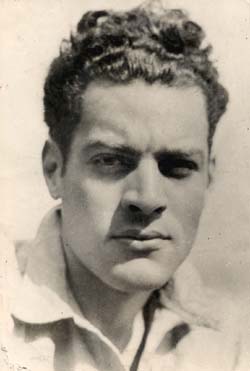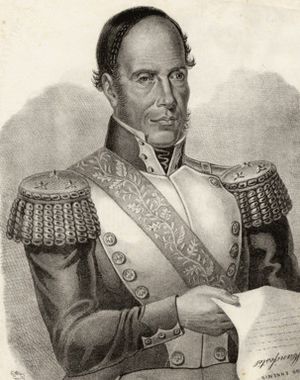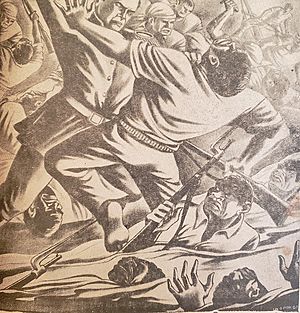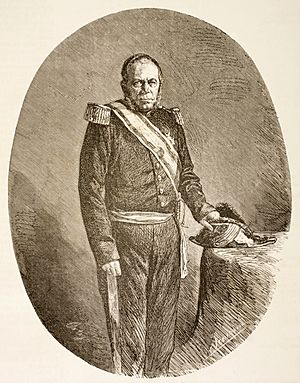Matías Ramón Mella facts for kids
Quick facts for kids
Matías Ramón Mella
|
|
|---|---|
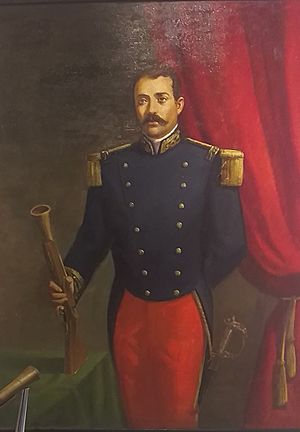
Portrait of Mella, in his military uniform, holding his iconic blunderbuss, c. 1840s-1850s
|
|
| In office September 26, 1849 – April 8, 1850 |
|
| President | Buenaventura Báez |
| Preceded by | Jacinto de la Concha |
| Succeeded by | Manuel Joaquín del Monte |
| Governor of Santiago | |
| In office 1844-1844 |
|
| In office September 14, 1863 – June 4, 1864 |
|
| President | José Antonio Salcedo |
| Preceded by | Benigno Filomeno de Rojas |
| Succeeded by | Ulises Francisco Espaillat |
| Personal details | |
| Born | office February 25, 1816 Santo Domingo, Captaincy General of Santo Domingo (now Santo Domingo, Dominican Republic) |
| Died | June 4, 1864 (aged 48) Santiago de los Caballeros, Dominican Republic |
| Resting place | Altar de la Patria |
| Nationality | Dominican |
| Political party | Central Government Junta |
| Other political affiliations |
La Trinitaria |
| Spouse |
Josefa Brea
(m. 1836) |
| Relations | Julio Antonio Mella (grandson) |
| Children | 4 |
| Parents | Antonio Mella Álvarez and Francisca Javier Castillo Álvarez |
| Profession | Politician, military officer, and revolutionary |
| Known for | Founding father of the Dominican Republic |
| Awards | National hero |
| Nickname | Ramón |
| Military service | |
| Allegiance | |
| Branch/service |
|
| Years of service | 1838 – 1864 |
| Rank | General |
| Battles/wars | Dominican War of Independence Cibaeño Revolution |
| Honors | Order of Merit of Duarte, Sánchez and Mella |
Matías Ramón Mella Castillo (February 25, 1816 – June 4, 1864) was a brave Dominican revolutionary, politician, and military general. He was best known by his middle name, Ramón. Mella is seen as a national hero in the Dominican Republic. He is one of the three founding fathers of the Dominican Republic, along with Juan Pablo Duarte and Francisco del Rosario Sánchez. The important Order of Merit of Duarte, Sánchez and Mella is partly named in his honor.
Mella dreamed of an independent Dominican Republic, free from any foreign control. He was a loyal and honorable man. His strong desire to create and keep a free nation grew from a young age. He was a key part of the group that helped end Haitian rule in Santo Domingo.
Mella played a very important role in making the Dominican Republic an independent country. But this freedom was not easy to keep. Mella and his fellow patriots often had disagreements with others who had fought alongside them. Even when he was sick and had little money, he continued to fight for his country. In 1861, the country was given back to Spain, which started another war. Despite this, Mella kept serving as a revolutionary leader until he passed away on June 4, 1864.
Contents
Early Life and Family Background
Mella was born on February 25, 1816, in Santo Domingo. His parents were Antonio Mella Álvarez and Francisca Javier Castillo Álvarez, who were from the Canary Islands. He had two siblings, Idelfonso and Manuela.
Not much is known about his school days. Because there were few public schools back then, it is thought his parents sent him to private schools. There, he received a good education from respected Dominican teachers.
From a young age, Mella was skilled with a sword. He was known for being brave and fearless, even as a teenager. He spent his early life doing useful work for his community.
In 1835, during the time Haiti ruled the Dominican Republic, Mella was a community leader in San Cristóbal. He worked in the wood-cutting business. He shared this work with Antonio Duvergé, another future military general. Duvergé noticed Mella's skill with a sword. This, along with their shared dislike of Haitian rule, led to a strong friendship. This friendship would be very important later on.
His work in wood cutting and trade helped him meet many different kinds of people. This allowed him to understand how society worked.
In 1836, when he was 20, Mella married Josefa Brea. She came from a wealthy family. They had four children: Ramón María, Dominga América María, Antonio Nicanor, and Ildefonso. Antonio Nicanor later became the father of Julio Antonio Mella, a Cuban activist.
One of the witnesses at Mella's wedding was Juan Isidro Perez, who became his friend. Through this friendship, Mella learned about the activities of the revolutionary leader Juan Pablo Duarte.
Understanding Mella's Name
In many official papers, like his baptism and marriage certificates, Mella's name is written as Ramón Mella Castillo. There is not much proof that his name was Matías Ramón Mella, except for a few documents he signed as MR Mella or M. Ramón Mella.
Even in letters he wrote to family and friends, they never called him Matías. This has caused some confusion in history books about his full name. However, today he is most often known as Matías Ramón Mella.
Mella as a Revolutionary Leader
Joining Duarte's Movement
Mella's friendship with Juan Isidro Perez led him to meet Juan Pablo Duarte. At that time, Duarte was looking for new members for La Trinitaria. This was a secret group that wanted to make the Dominican Republic independent from Haitian rule. Mella was happy to join. He also met other new members like José María Serra de Castro and Francisco del Rosario Sánchez. Mella and Sánchez would later make history together.
For five years, the Trinitarios worked to spread ideas of independence. When Haitian leaders found out about the group, they had to create two new, more open organizations: La Filantrópica and La Dramática. These groups helped raise awareness more safely. During these years, Mella and Sánchez stood out and earned Duarte's full trust.
Duarte saw Mella as a man with great discipline and leadership skills. He sent Mella to Haiti in January 1843. Mella's mission was to find allies to help overthrow the Haitian leader, Jean-Pierre Boyer. Mella stayed with Jérôme-Maximilien Borgella, a Haitian general. Boyer's rule was becoming unpopular because of high taxes that only benefited France. Groups in Haiti also wanted to overthrow Boyer. Duarte thought this was a good chance for the Dominicans.
Mella met Charles Hérard, a Haitian opposition leader. Hérard led a reform movement. Mella quickly made agreements with these Haitian revolutionaries. Thanks to Mella's diplomatic skills, the Trinitarios were able to work with the Haitian Reformists. Together, they managed to overthrow Boyer in May 1843. Hérard did not know that the Dominicans' real goal was to gain full independence from Haiti.
In June 1843, Duarte asked Mella to return to Santo Domingo. His new mission was to spread the ideas of independence. So, in July 1843, Mella went to the Central Cibao region to promote his ideas. However, Hérard, who was now the president of Haiti, found out about Mella's true plans. He traveled to the eastern part of the island to arrest the plotters. Mella was imprisoned in Port-au-Prince for two months. But a rebellion broke out in the city against Hérard. Hérard was only able to control it with Mella's help and other prisoners he freed.
The Manifesto of January 16, 1844
As problems continued in Haiti, Mella used the chance to return to Santo Domingo. He wanted to move to the next step of independence. But Duarte was not there; he had been exiled by the Haitians. So, the leadership of the revolution went to Sánchez. They decided that the declaration of independence would be on February 27.
In January 1844, Sánchez wrote a declaration of independence. Mella suggested giving it to Tomas Bobadilla, a conservative leader, to publish. The final version, released on January 16, included signatures from members of both groups, including Mella, Sánchez, and Bobadilla.
Declaring Dominican Independence
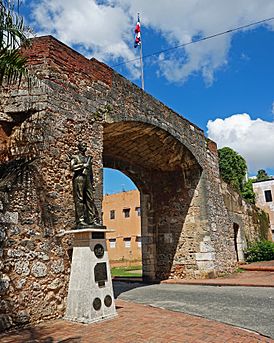
Stories differ about the famous "blunderbuss" shot. It is said that on the night of February 27, 1844, Mella met with other revolutionaries at Puerta de La Misericordia (Mercy Gate). People were unsure and worried. To end the hesitation, Matías Ramón Mella fired his blunderbuss into the air. After this, the patriots marched to the San Gennaro stronghold (now Conde Gate). There, Francisco del Rosario Sánchez announced the birth of the Dominican Republic to the world.
Eustache Juchereaux Saint Denys, a French consul in Santo Domingo, heard the shot. He wrote:
The night of the 27th was the day set for that attempt. The authority was on guard, the general restlessness, it was hoped, however, that the order would not be disturbed. The Vicar General, the most influential people in the city made useless efforts to bring more reasonable sentiments to that youth. They were unbreakable, and as they announced, the signal was given at 11 at night by a rifle shot fired into the air.
José María Serra de Castro, one of La Trinitaria's founders, wrote about the event. He said that when the groups met at La Misericordia, fewer people showed up than expected. He explained:
"The situation is compromised," said Mella. "Lets play everything for everything," and he fired his blunderbuss into the air.
Another writer, Don Manuel de Jesús Galván, described it this way:
The important hour arrived: a group of patriots waited anxiously for those who were late at a quiet spot called La Misericordia. They counted those who arrived with worry; most of those who promised to come were missing. One faithful person finally arrived, saying, "I think everything is discovered, a patrol chased me." These words made the few listeners suspicious. Someone, scared, talked about going home and giving up. "NO," a strong voice answered firmly, breaking the night's silence. "There is no turning back; cowards and brave alike, we all must go to the end. Long live the Dominican Republic!" he said, and a loud shot from his gun emphasized the heroic cry. No one hesitated anymore: everyone risked their lives and ran towards the famous Puerta del Conde. The bold shot by the fearless Ramón Mella announced to the world the birth of the Dominican Republic.
The Independent Republic
After the Dominican Republic was declared, Mella joined the Central Government Board, with Sánchez as president. On March 2, Mella wrote to Duarte, who was in Curaçao, telling him about the successful revolt. A few days later, Mella went to the Cibao region. He wanted to enlist José María Imbert from Moca as the second-in-command of the new National Army. Mella also became the governor of Santiago and a delegate for the Central Government Board.
Suddenly, Mella heard that the new Haitian president, Jean-Louis Pierrot, was coming to attack Santiago. Mella quickly traveled around the region to warn his comrades and gather more soldiers. He told Imbert, who was now a lieutenant, to prepare for the attack. Imbert's forces successfully pushed back the Haitian army in the Battle of Santiago.
After the victory in the Battle of Azua, the Dominican Republic was independent. When Duarte returned, Mella voted to make him president of the Central Government Board. Mella wanted to prevent any foreign power from taking over the country again. He wrote to Sánchez:
These towns had no more disturbances than the coming of the Delegation; This ended with the arrival of Juan Pablo, thank God! Finally, I conclude by telling you that my wish has arrived and I will return it, President of the Dominican Republic.
Even though the Haitians were expelled, many people in the country felt the new nation could not survive alone. They thought it needed to be linked to a colonial power. This caused a big split between the independent Trinitarians and those who wanted annexation. This led to public arguments, which sometimes turned violent.
For example, Tomás Bobadilla, a conservative leader who wanted to link the Dominican Republic to France, was removed from power by a coup led by Sánchez and Mella. In response, military general Pedro Santana led his own coup. He sent Duarte, Mella, and Sánchez into exile. These conflicts continued, forcing more patriots out of the country. Some, like María Trinidad Sánchez (Francisco del Rosario Sánchez's aunt) and Antonio Duvergé, even died. These losses made Mella very sad.
While in exile, Mella chose to stay in Puerto Rico, close to his homeland. In 1848, Mella and Sánchez were allowed to return to the country by President Manuel Jimenes. Mella settled in Puerto Plata and worked in wood cutting, staying away from politics for a while. He later held many important positions. He rejoined the army and fought in the Battle of Las Carreras, another Haitian invasion, and won again. But this victory helped Santana gain more power, and he overthrew Jimenes.
When Buenaventura Báez became president in September 1849, Mella was appointed Secretary of State for Commerce and the Treasury. He also served briefly as Minister of Finance from 1849 to 1850.
When Santana returned for a third term, Mella became a Secretary in his government. He was also named Commander of Arms and Governor. In 1854, he was sent on a special mission to Spain to get them to recognize Dominican independence. This mission lasted six months. During talks, Spanish officials tried to convince Mella to suggest that the Dominican government become a protectorate of Spain, instead of being fully independent. Mella, still believing in the Trinitarios' ideals, refused this offer. By May 1854, Mella decided to return to the Dominican Republic. He wrote a farewell letter to the Count of San Luis, expressing his frustration that Spain would not recognize their independence.
In July 1856, Mella was asked to write a plan to organize the army. This showed his skills as a military leader once again.
In July 1857, a revolution began in Santiago against Buenaventura Báez. Báez's financial mistakes had caused a crisis in the country. Mella was one of the first to join this movement. In this civil war, Mella became very famous for bravely taking control of Plaza de Semaná in May 1858. For this heroic act, he received a joyful welcome from the people of Santiago.
During this time, the nation faced political and economic problems. Buenaventura Báez had bankrupted the national treasury for his own gain and wanted the country to be annexed by the United States. Santana, on the other hand, ruled as a military dictator and kept suggesting that the country join Spain. Mella strongly disagreed with this idea.
Haiti also kept trying to reconquer the Dominican Republic. Haiti's new leader, Faustin Soulouque, even declared himself emperor and made many attempts to take control of the island. From 1849 to 1856, Soulouque tried several times. In one instance, he led an army of 30,000 men into the eastern part of the island. But his efforts failed, and his army retreated after heavy losses. Soulouque was later overthrown in 1859 and sent into exile.
Final Fight for Independence
Spain Returns to Rule
Even though the country was independent, it was still in trouble. After the war, Santana's government was bankrupt and almost collapsing. His poor leadership and Báez's corrupt government had drained the country's money. Facing economic problems and fearing another invasion from Haiti, Santana sought help from a foreign power. After failing to agree with France, he turned to Spain and Queen Isabella II. In exchange for special privileges and military and economic help, Santana agreed to make the Dominican Republic a colony again. Spain, which was losing control of its other colonies, used this chance to regain power in Latin America. The U.S. was busy with its Civil War and could not stop this. This decision made many people in the Dominican Republic very angry. Mella, of course, did not accept this. He and other patriots strongly opposed the annexation. Because of this, Santana imprisoned Mella in the Tower of Homage (now Ozama Fortress) for 72 days. He was then sent away to Saint Thomas.
On March 20, 1861, the annexation to Spain was completed, and Spanish troops began arriving. Mella quickly returned to his homeland, but it was difficult because he had no money or military support. While on an English ship stuck in Puerto Rico, he tried to get the crew to help him land in the Dominican Republic to start his revolution, but he was unsuccessful.
On June 3, Mella wrote a letter to Santana, again stating his opposition to the annexation. He called Santana's actions a betrayal. He wrote that he was a citizen of the Dominican Republic and would always serve his country. He also said that Spain should recognize the Dominican Republic's independence, not try to take it over.
A month later, Mella received the sad news that Sánchez, who also led a rebellion against the annexation, was executed on Santana's orders on July 4, 1861.
Continuing the Resistance
Mella, even though he was battling dysentery (a serious illness), did not give up. He joined the fight. He traveled through the southern regions, gathering troops for General Pedro Florentino. For his efforts, he was made Minister of War. His first act in this role was to create a war manual for soldiers in January 1864. This manual gave important advice on how to fight against a larger, more disciplined enemy. It focused on using clever tactics, like surprise attacks and guerrilla warfare, to wear down the Spanish forces.
Around the same time, Mella wrote a message to all Dominicans, urging them to fight against the Spanish Empire to restore their independence. He reminded them of past heroes and called for revenge against those who betrayed the country. He told them that the Republic still existed and that they must fight for freedom. He emphasized that fighting for freedom was not a crime when it was the only way to escape oppression. He also stated that America should be free from old European powers.
At the time of the Capotillo Outcry (August 16, 1863), Mella was very ill. Yet, he served as Vice President of the Dominican Republic in the government that was fighting for restoration. He held this position until his death. Before he passed away, Mella asked his followers to wrap his body in the Dominican flag when he died. He spent his final years in Santiago, continuing his duties.
Duarte's Last Visit
On March 27, Duarte, who had just arrived in the country, visited Mella at his home. Duarte wanted to see his sick friend one last time. The hero Manuel Rodríguez Objío described this visit:
He visited the famous Mella on March 7, a soldier of two great eras, who was lying on his deathbed in a small house, one of the temporary ones built after the fire and near Fort San Luis. Duarte hugged him there, after 20 years of being apart. Duarte was upset by how poor Mella was, a man who had been a great military leader and a national hero. Mella told Duarte that since he wouldn't live to see his homeland free, he wanted to be buried wrapped in the national flag. This request moved Duarte, who shed tears while giving him a last hug.
On June 4, 1864, during the war, Mella, the beloved founding father, died in his small home near San Luis Fortress. He was only 48 years old. His wife, Josefa, family, and neighbors were with him. As he wished, his body was wrapped in the Dominican flag and buried.
The Dominican Restoration War continued after Mella's death. Many lives were lost on both sides. But Mella's war manual became very important for the Dominican rebels. Even though they were outnumbered, they continued to win against Spain. This led to the Dominicans' final victory. They successfully drove the Spanish forces off the island and restored their independence in 1865. Santana, disgraced and facing trial, died on June 29, 1864, just 25 days after Mella.
Mella's Lasting Legacy
Mella was a man of great military talent and one of the most important figures in Dominican history. Among the founding fathers, Mella showed the most active and determined spirit. He was a man of respect and dignity. His loyalty to his friends and his nation was a strong force in his life. From joining the Trinitarios, fighting battles with Haiti, dealing with internal conflicts, and the war against Spain, Mella always kept his word. Even during the difficult times between the Dominican War of Independence and the Spanish occupation of the Dominican Republic, his dream of an independent Dominican state stayed with him until the very end. Before he died, during the Spanish occupation, Mella was quoted saying:
There is still a homeland, long live the Dominican Republic.
Until 1891, Mella's body remained buried in Santiago. Then, at the request of a group called Sociedad Hijos del Pueblo, his remains were moved to Santo Domingo. There, he was buried alongside Duarte and Sánchez in the Chapel of the Immortals at the Primate Cathedral of America.
Three years later, in 1894, dictator Ulises Heureaux officially declared Duarte, Mella, and Sánchez as the Founding Fathers of the Dominican Republic. Since then, Dominicans honor Mella and his companions as the founders of their nation. On February 27, 1944, 100 years after independence, Rafael Trujillo ordered their remains to be moved again. They were placed at Puerta del Conde, where they now rest in the Altar de la Patria, a special monument.
Mella received many honors for his revolutionary work:
- He is buried in a beautiful tomb, the Altar de la Patria, at the Count's Gate (Puerta del Conde) with Duarte and Sánchez.
- The city of Mella in Independencia is named after him.
- Many streets in the Dominican Republic are named in his honor.
- There is a statue of him in Santo Domingo.
- Mella is shown alone on the 10 Dominican peso note and coin. He is also on the 100 Dominican peso note with Duarte and Sánchez.
- A Dominican anthem is dedicated to his memory.
|
See also
 In Spanish: Ramón Matías Mella para niños
In Spanish: Ramón Matías Mella para niños
- History of the Dominican Republic
- España Boba
- Dominican War of Independence
- Dominican Restoration War
- Military of the Dominican Republic
- Dominican Army
- Juan Pablo Duarte
- Francisco del Rosario Sánchez
- Antonio Duvergé
- José Maria Imbert



